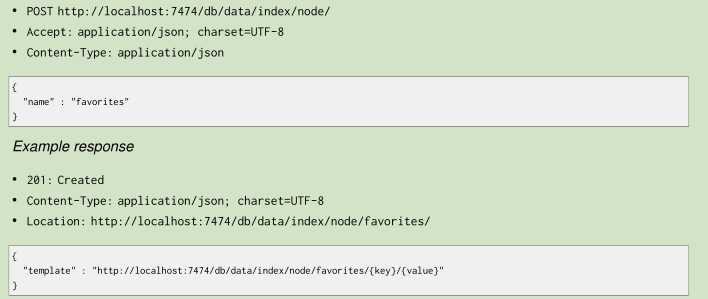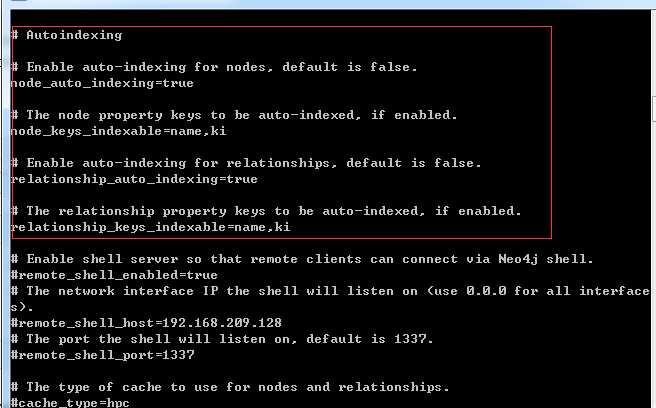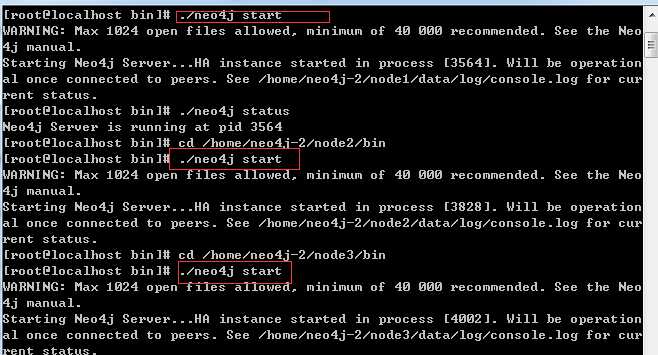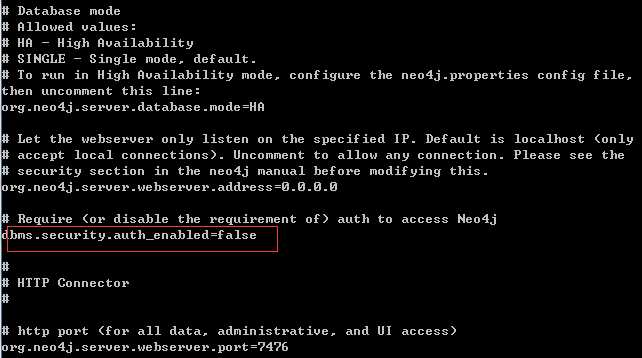标签:
一、创建Neo4j的Legacy indexing
1.为节点创建索引
官方API的创建示例为:

将一节点添加至索引:
public static void AddNodeIndex(String nid) { String txUri=SERVER_ROOT_URI+"index/node/favorites"; WebResource resource = Client.create().resource(txUri); String entity="{\"value\" : \"n204\",\"uri\" : \"http://192.168.209.128:7474/db/data/node/"+nid+"\",\"key\" : \"n201\"}"; ClientResponse response = resource.accept(MediaType.APPLICATION_JSON) .type(MediaType.APPLICATION_JSON).entity(entity) .post(ClientResponse.class); System.out.println(response.getStatus()); System.out.println(response.getEntity(String.class)); response.close(); }
ps:nid是要添加索引的节点ID value是索引值 key是索引名称
2.通过属性查找节点
public static void GetNodeByIndex() { String txUri=SERVER_ROOT_URI+"index/node/favorites/n201/n201"; WebResource resource = Client.create().resource(txUri); ClientResponse response = resource.accept(MediaType.APPLICATION_JSON) .type(MediaType.APPLICATION_JSON) .get(ClientResponse.class); System.out.println(response.getStatus()); System.out.println(response.getEntity(String.class)); response.close(); }
txUri路径中:favorites为刚创建的索引名称,第一个n201是节点索引key,第二个n201是节点索引值
二、自动创建索引(Legacy Automatic Indexes)
What default configuration means depends on how you have configured your database. If you haven’t
changed any indexing configuration, it means the indexes will be using a Lucene-based backend.
数据库配置之后,就可以自动创建索引
1.配置文件配置
Auto-indexing must be enabled through configuration before we can create or configure them. Firstly
ensure that you’ve added some config like this into your server’s conf/neo4j.properties file:
打开conf/neo4j.properties文件如图
配置下面的节点
# Enable auto-indexing for nodes, default is false. node_auto_indexing=true # The node property keys to be auto-indexed, if enabled. node_keys_indexable=name,ki # Enable auto-indexing for relationships, default is false. relationship_auto_indexing=true # The relationship property keys to be auto-indexed, if enabled. relationship_keys_indexable=name,ki
Node_keys_indexable、relationship_keys_indexable对应节点、关系的属性
配置完成之后重启服务

重启三个节点的集群
2。测试索引
插入一个节点和关系
// 创建节点 @Test public void test2() { URI uri = CreateSimpleGraph.createNode(); CreateSimpleGraph.addProperty(uri, "name", "张三"); URI uri1 = CreateSimpleGraph.createNode(); CreateSimpleGraph.addProperty(uri1, "name", "李四"); } // 为节点设置关系 @Test public void test6() { for (int i = 1; i < 2; i++) { try { URI suri = new URI("http://192.168.209.128:7474/db/data/node/171391"); String uri1="http://192.168.209.128:7474/db/data/node/"; URI euri = new URI("http://192.168.209.128:7474/db/data/node/171392"); URI reluri= CreateSimpleGraph.addRelationship(suri, euri, "家人","{\"ki\" : \"1234567890\", \"name\" : \"无\" }"); System.out.println(reluri); } catch (URISyntaxException e) { // 异常信息输出该内容 e.printStackTrace(); } } }
3.通过属性查找节点
public static void GetNodeByAutoIndex(String ki) { // String txUri=SERVER_ROOT_URI+"index/node/node_auto_index/name/"+ki; String txUri=SERVER_ROOT_URI+"index/auto/node/ki/"+ki; WebResource resource = Client.create().resource(txUri); ClientResponse response = resource.accept(MediaType.APPLICATION_JSON) .type(MediaType.APPLICATION_JSON) .get(ClientResponse.class); System.out.println(response.getStatus()); System.out.println(response.getEntity(String.class)); response.close(); } public static void GetRelationshipByAutoIndex(String ki) { // String txUri=SERVER_ROOT_URI+"index/node/node_auto_index/name/"+ki; String txUri=SERVER_ROOT_URI+"index/auto/relationship/ki/"+ki; WebResource resource = Client.create().resource(txUri); ClientResponse response = resource.accept(MediaType.APPLICATION_JSON) .type(MediaType.APPLICATION_JSON) .get(ClientResponse.class); System.out.println(response.getStatus()); System.out.println(response.getEntity(String.class)); response.close(); }
关系的输出结果为:
[ { "extensions" : { }, "metadata" : { "id" : 337, "type" : "家人" }, "data" : { "name" : "无", "ki" : "1234567890" }, "property" : "http://192.168.209.128:7474/db/data/relationship/337/properties/{key}", "start" : "http://192.168.209.128:7474/db/data/node/171391", "self" : "http://192.168.209.128:7474/db/data/relationship/337", "end" : "http://192.168.209.128:7474/db/data/node/171392", "type" : "家人", "properties" : "http://192.168.209.128:7474/db/data/relationship/337/properties" } ]
这里说明一下,传值为中文的时候,查询不出来,可能需要编码,因为工作暂时没有用到,就没有再研究了
三、NEO4J批量插入和用户密码问题
1.批量操作
批量操作的官方文档地址:http://neo4j.com/docs/milestone/rest-api-batch-ops.html
public static int BatchInserterNode(String body) { // String // body="[{\"method\":\"POST\",\"to\":\"/node\",\"body\":{\"name\":\"aaa\",\"lead\":\"aaa1\"},\"id\":0},{\"method\":\"POST\",\"to\":\"/node\",\"body\":{\"name\":\"bbb\",\"lead\":\"bbb1\"},\"id\":1}]"; // POST {} to the node entry point URI ClientResponse response = GetResourceInstance("batch") .accept(MediaType.APPLICATION_JSON) .type(MediaType.APPLICATION_JSON).entity(body) .post(ClientResponse.class); // System.out.println(String.format( // "POST to [%s], status code [%d], location header [%s]", // nodeEntryPointUri, response.getStatus(), location.toString())); String entity = response.getEntity(String.class); response.close(); int status = response.getStatus(); return status; } //调用 //批量插入速度测试 @Test public void test10() { StringBuilder sbody=new StringBuilder(); sbody.append("["); for (int i = 161337; i < 171337; i++) { if(i>161337) { sbody.append(","); } sbody.append("{"); sbody.append("\"method\":\"POST\",\"to\":\"/node\",\"body\":{\"name\":\"n"+i+"\",\"lead\":\"a"+i+"\"},\"id\":"+i+""); sbody.append("}"); } sbody.append("]"); long st = System.currentTimeMillis(); int status= CreateSimpleGraph.BatchInserterNode(sbody.toString()); System.out.println("插入状态:"+status); long et = System.currentTimeMillis(); System.out.println("插入10000条数据总共耗时:" + (et - st) + "毫秒"); }
批量插入的速度10000条大概在6秒左右吧
2.NEO4J密码操作
本次用的版本是:neo4j-enterprise-2.2.0-unix,连接数据库的时候需要输入用户名称密码。上个版本好像是不用的。
使用密码时:
public void checkDatabaseIsRunning() { // START SNIPPET: checkServer WebResource resource = Client.create().resource(SERVER_ROOT_URI); ClientResponse response = resource.get(ClientResponse.class); resource.addFilter(new HTTPBasicAuthFilter("neo4j", "123456")); if (response.getStatus() == 200) { System.out.println("连接成功!"); } else { System.out.println("连接失败!"); } // System.out.println(String.format("GET on [%s], status code [%d]", // SERVER_ROOT_URI, response.getStatus())); response.close(); // END SNIPPET: checkServer }
如不需要使用密码,可以在配置文件进行配置
vi /conf/neo4j-server.properties这个文件

这里改成false即可,默认是True
参考文档
http://neo4j.com/docs/milestone/rest-api-batch-ops.html
http://neo4j.com/docs/milestone/rest-api-auto-indexes.html
http://neo4j.com/docs/milestone/rest-api-security.html
标签:
原文地址:http://www.cnblogs.com/nyzhai/p/4515102.html